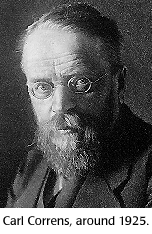Concept 6 Genes are real things.




 Hugo de Vries, Carl Correns and Erich von Tschermak-Seysenegg were the three scientists who rediscovered Mendel's laws in 1900. They were all working independently on different plant hybrids, and came to the same conclusions about inheritance as Mendel. Robert Hooke was one of the first scientists to describe a cell. Theodor Schwann redefined the cell as a living unit.
Hugo de Vries, Carl Correns and Erich von Tschermak-Seysenegg were the three scientists who rediscovered Mendel's laws in 1900. They were all working independently on different plant hybrids, and came to the same conclusions about inheritance as Mendel. Robert Hooke was one of the first scientists to describe a cell. Theodor Schwann redefined the cell as a living unit.
Carl Erich Correns (1864-1933)

Carl Correns was born in Münich, Germany, and was orphaned at an early age. He was raised by his aunt in Switzerland. In 1885, he entered the University of Münich to study botany. Carl Nägeli, the botanist to whom Mendel wrote to about his pea plant experiments, was no longer lecturing at Münich. Nägeli, however, knew Correns' parents and took an interest in him. Nägeli was the one who encouraged Correns' interest in botany and advised Correns on his thesis subject. Nägeli and Correns' connection was more than just scientific; Correns eventually married Nägeli's grandniece.
Correns was a tutor at the University of Tübingen when he began to experiment with trait inheritance in plants in 1892. Correns already knew about some of Mendel's hawkweed plant experiments from Nägeli. Nägeli, however, never talked about Mendel's key pea plant results, so Correns was initially unaware of Mendel's laws of heredity. However, by 1900, when Correns submitted his own results for publication, the paper was called: G. Mendel's Law Concerning the Behavior of the Progeny of Racial Hybrids. Correns and de Vries were the ones who most clearly "redefined" Mendel's laws. Mendel, in his paper, spoke about the "law of combination of different characters" and talked about "the law of independent assortment." Mendel implied that the segregation of factors occurred in the production of sex cells. Correns (with credit to de Vries) restated Mendel's results, giving us Mendel's law of segregation and Mendel's law of independent assortment.
Correns was active in genetic research in Germany, and was modest enough to never have a problem with scientific credit or recognition. He believed that his other work was more important, and the rediscovery of Mendel's laws only helped him with his other work. Correns was supposedly indignant that Hugo de Vries did not mention Gregor Mendel in the first printing of de Vries' paper. Credit should be given where due.
In 1913, Correns became the first director of the newly founded Kaiser Wihelm Institut für Biologie in Berlin-Dahlem. Unfortunately, most of his work was unpublished and destroyed when Berlin was bombed in 1945.


Theodor Schwann recognized that eggs, ova, are cells. In 1841, sperm were classified as cells when they were seen developing from testis cells.

What is the largest single cell in existence?
 Children resemble their parents.
Children resemble their parents. Genes come in pairs.
Genes come in pairs. Genes don't blend.
Genes don't blend. Some genes are dominant.
Some genes are dominant. Genetic inheritance follows rules.
Genetic inheritance follows rules. Genes are real things.
Genes are real things. All cells arise from pre-existing cells.
All cells arise from pre-existing cells. Sex cells have one set of chromosomes; body cells have two.
Sex cells have one set of chromosomes; body cells have two. Specialized chromosomes determine sex.
Specialized chromosomes determine sex. Chromosomes carry genes.
Chromosomes carry genes. Genes get shuffled when chromosomes exchange pieces.
Genes get shuffled when chromosomes exchange pieces. Evolution begins with the inheritance of gene variations.
Evolution begins with the inheritance of gene variations. Mendelian laws apply to human beings.
Mendelian laws apply to human beings. Mendelian genetics cannot fully explain human health and behavior.
Mendelian genetics cannot fully explain human health and behavior.